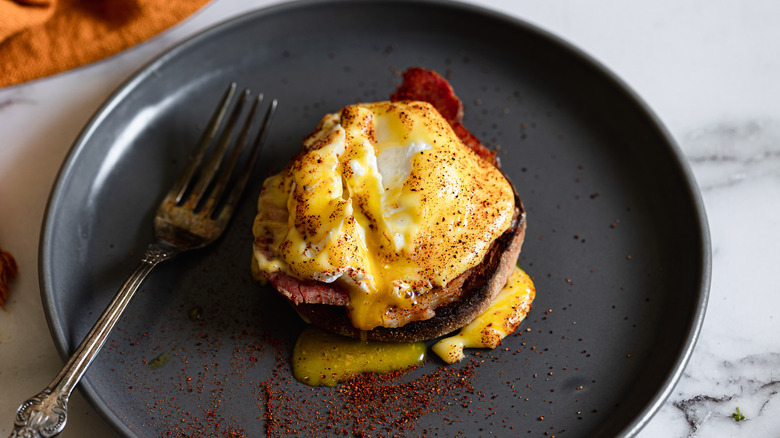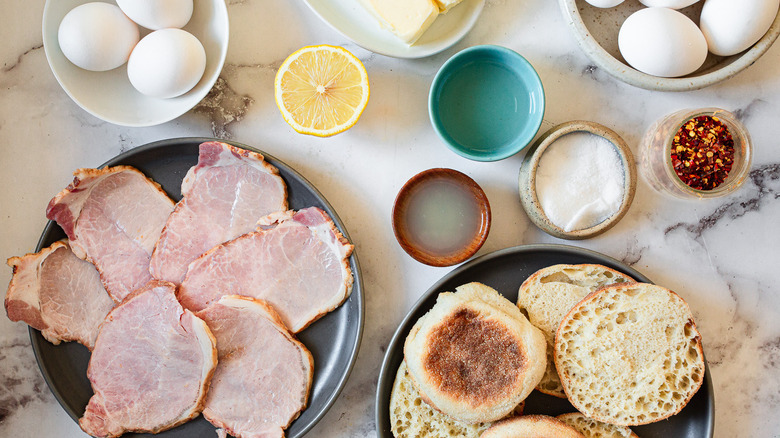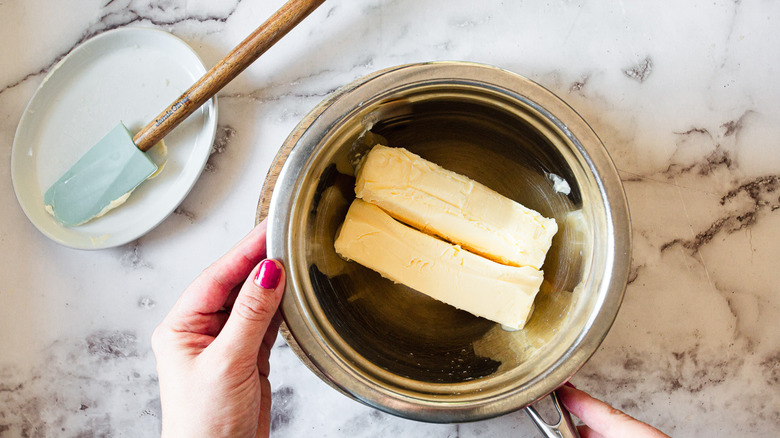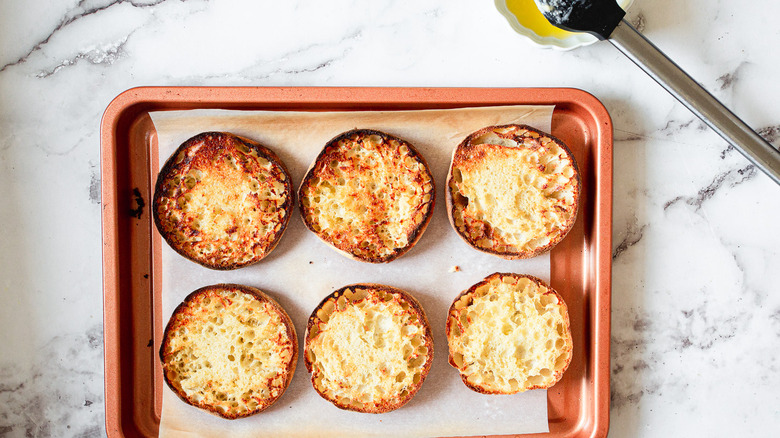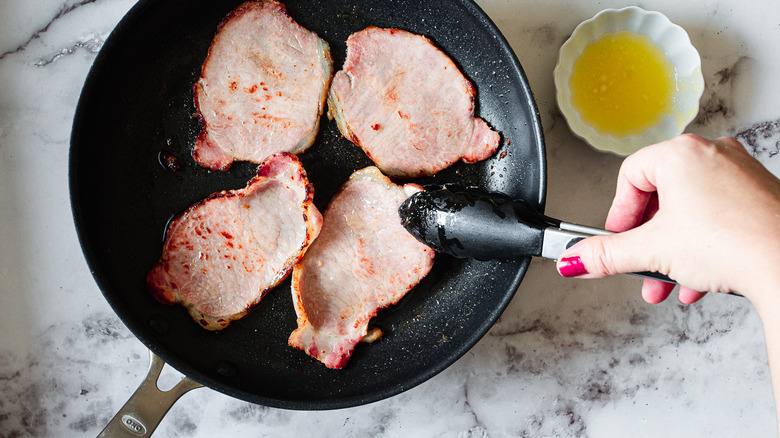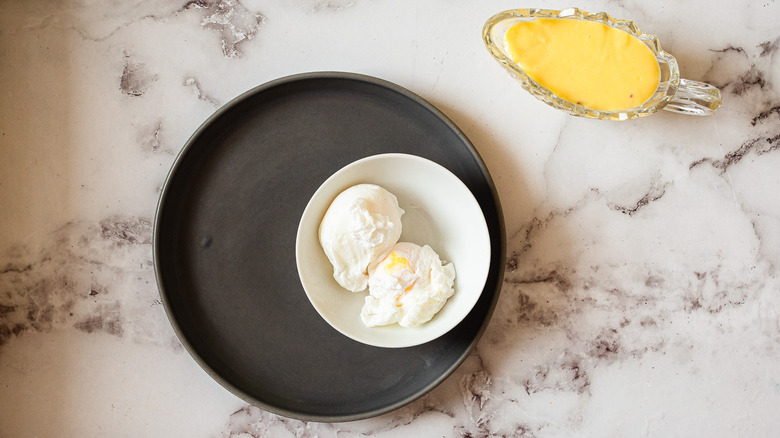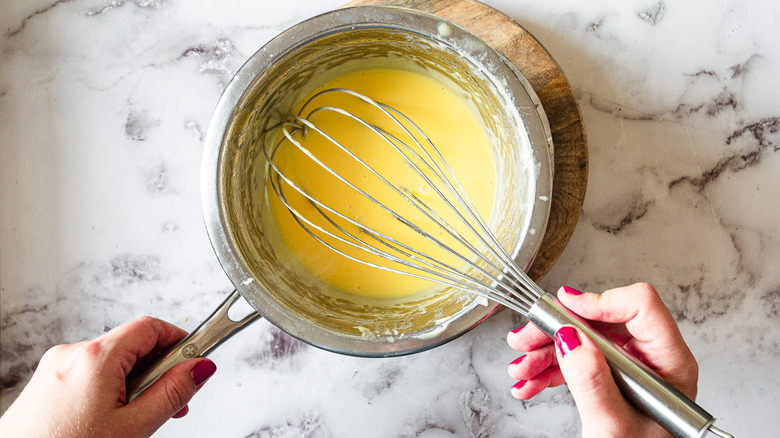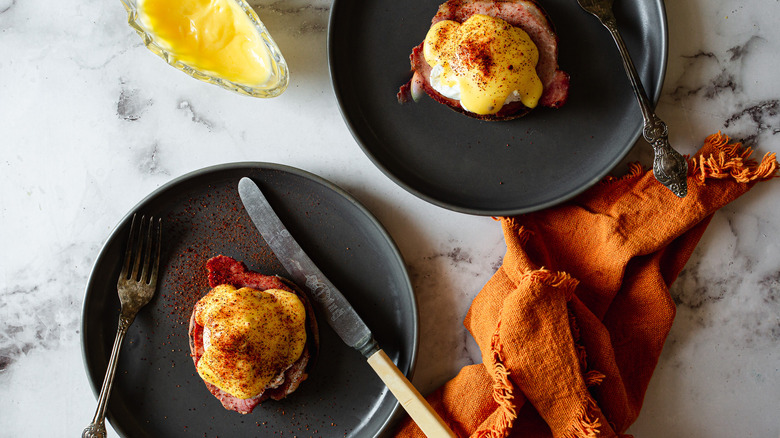Traditional Eggs Benedict Recipe
A traditional eggs Benedict is the undisputed royalty of the brunch table, due to its meticulous preparation and beautiful appearance. It's hard to picture a dish more synonymous with fancy brunches, but it's actually not that complicated to make. What sets apart the expert cooks from the amateurs is the ability to prepare this dish properly — and that requires multitasking.
We first begin by prepping some things in advance – toasting English muffins and clarifying the butter, which means separating the fat from the milk solids. The next step in properly made eggs Benedict is poaching the eggs. Luckily, this can actually be done in advance; if your brunch is not ready to be served, simply submerge the eggs into an ice bath, then plop them back into a pot of hot water to warm them through right before serving.
And finally, the crowning glory of traditional eggs Benedict is the hollandaise sauce, which French cooking lore decrees must be made with clarified butter. This needs to be done à la minute, so this will be the last step before serving our dish to the table. It's a lot of steps, but if you follow our step-by-step guide, it's absolutely feasible.
Gather the eggs Benedict ingredients
To make eggs Benedict the classic way, you will likely need to make a trip to a well-stocked butcher. Canadian bacon is at the heart of the traditional rendition of this dish, and unfortunately, many grocery stores do not carry this glorious cut of meat.
The rest of the ingredients are easy enough to find in any supermarket. You will need unsalted butter, English muffins, vinegar (for poaching the eggs), eggs, lemon juice, salt, and, if you're looking for just a hint of kick, cayenne pepper.
Make the clarified butter
Heat a small saucepan filled with 1 inch of water over medium heat until steaming. Place a medium heatproof bowl over the steaming water.
Add butter to the bowl and let it melt completely. After about 10 minutes, you'll notice the butter has separated, and the milk solids have sunk to the bottom of the bowl. Skim any milk solids that may be floating on the top, then slowly pour the clarified butter through a fine-mesh sieve lined with cheesecloth. You want to pour out only the clear yellow butter, so make sure you stop pouring as soon as the opaque milk solids are left!
Reserve both the clarified butter and milk solids separately, and keep the clarified butter warm.
Toast the English muffins
Preheat the oven to 450 F. Place the English muffins on a sheet pan, nooks and crannies facing up, and brush each with the reserved milk solids. Bake the English muffins until they're golden and crisp, which should take 4 to 5 minutes. Keep warm.
Fry the Canadian bacon
In a large skillet, heat 2 tablespoons of the preserved clarified butter over medium-high heat. Add the Canadian bacon and cook, flipping once, until golden, 2 to 3 minutes per side. Keep warm.
Poach the eggs
Prepare a large pot of salted water and add the vinegar. Heat it to 180 F, or where there is visible steam coming off the surface of the pot, but the water is not actually simmering.
Once the pot of vinegar water comes to the right temperature, crack your eggs into 6 small bowls. Use a slotted spoon to make a whirlpool in the water. Then, one at a time, drop the eggs into the center of the pot. Poach, gently stirring occasionally until the white is cooked and the yolk is still runny. This will take 3 to 4 minutes.
As soon as the eggs are poached, remove them with a slotted spoon and gently dab with a paper towel to dry. If you are not ready to serve the eggs, set them into an ice bath or arrange them on a baking sheet. You can then reheat them for a few minutes in a pot filled with poaching-temperature water once you are ready to serve.
Make hollandaise sauce
Refill that small saucepan from Step 1 with an inch of water and heat over medium until the water is steaming. Place another medium heatproof bowl over the steaming water.
To the bowl, add 3 egg yolks, lemon juice, and a large pinch of salt. Whisk constantly until the egg yolks are pale yellow and thick, 1 to 2 minutes. Then, while continuing to whisk, slowly stream in ½ cup of the warm clarified butter (reserve any extra for other uses) until your sauce is thick and creamy. Season with salt and, if you wish, cayenne pepper.
Serve the traditional eggs Benedict
All your hard work has paid off, and your traditional eggs Benedict is ready to be served! Line up three plates (for proper restaurant presentation, you may want to warm them up in an oven set to 100 F). Place a divided English muffin on each plate, then top each half with a slice of Canadian bacon. Top with warm poached egg.
Finally, spoon some hollandaise over each egg, sprinkle with additional cayenne if you wish, and serve!
Traditional Eggs Benedict Recipe
Master the classic breakfast staple with toasted English muffins topped with seared Canadian bacon, a poached egg, and silky hollandaise sauce.
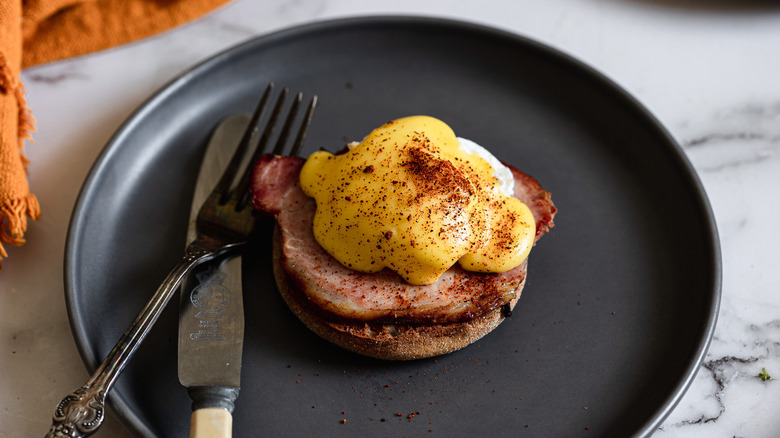
Ingredients
- 2 sticks unsalted butter
- 3 English muffins, opened
- 6 slices thick-cut Canadian bacon
- 2 tablespoons white distilled vinegar
- 6 eggs plus 3 egg yolks, divided
- 2 tablespoons lemon juice
- kosher salt, to taste
Optional Ingredients
- cayenne pepper, to taste
Directions
- Make the clarified butter: Heat a small saucepan filled with 1 inch of water over medium heat until steaming. Place a medium heatproof bowl over the steaming water. Place the butter in the bowl and let it melt completely. Let it sit until the butter has separated and the milk solids have sunk to the bottom of the bowl, about 10 minutes.
- Skim any milk solids that may be floating on the top, then slowly pour the clarified butter through a fine-mesh sieve lined with cheesecloth. You want to pour out only the clear yellow butter. Stop pouring as soon as the opaque milk solids are left, reserving both the clarified butter and milk solids separately. Keep the clarified butter warm as you proceed.
- Preheat the oven to 450 F. Place the English muffins on a sheet pan, nooks and crannies facing up, and brush each with the reserved milk solids. Bake until golden and crisp, 4 to 5 minutes. Keep warm.
- In a 12-inch skillet, heat 2 tablespoons of the clarified butter over medium-high heat. Add the Canadian bacon and cook, flipping once, until golden, 2 to 3 minutes per side. Keep warm.
- Prepare a large pot of salted water and add the vinegar. Heat to 180 F, or until there is visible steam coming off the surface of the pot, but the water is not yet simmering.
- Once the pot of vinegar water comes to 180 F, crack the whole eggs into 6 small bowls. Use a slotted spoon to make a whirlpool in the water. Then, one at a time, drop the eggs into the center of the pot.
- Poach, gently stirring occasionally, until the white is cooked and the yolk is still runny, 3 to 4 minutes.
- Make the hollandaise sauce: Refill the small saucepan from Step 1 with an inch of water and heat over medium until steaming. Place another medium heatproof bowl over the steaming water.
- To the bowl, add the 3 egg yolks, lemon juice, and a large pinch of salt. Whisk constantly until the egg yolks are pale yellow and thick, 1 to 2 minutes. Then, while continuing to whisk, slowly stream in ½ cup of the warm clarified butter (reserve any extra for other uses) until thick and creamy. Season with salt and, if using, cayenne pepper. Remove from heat and keep warm.
- Line up 3 plates. Place a two toasted English muffin halves on each plate, then top each half with a slice of Canadian bacon. As soon as the eggs are poached, remove them with a slotted spoon and dab gently with a paper towel to dry before placing over the Canadian bacon. Spoon some hollandaise over each egg.
- Sprinkle with additional cayenne if desired and serve immediately.
